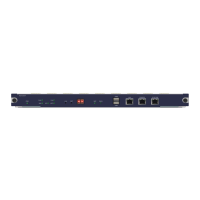ZXR10 GER (V2.6.03) General Excellent Router User Manual Volume-I
266 Confidential and Proprietary Information of ZTE CORPORATION
private WAN" is a technology to simulate a point-to-point leased
line on a common data network by using the private tunneling
technology.
On a virtual private network, the connection between any two
nodes does not have any end-to-end physical link necessary for
a traditional private network, but is dynamically set up by using
the resources of the public network. In addition, a VPN user also
can customize a network that best meet the actual requirements
and also can control contact with other users. Such a VPN also
supports dial-up users.
The tunneling technology, similar to the point-to-point
connection technology, is a basic VPN technology, which can set
up a data channel (tunnel) on a public network so that packets
can be transmitted on the tunnel.
A tunnel is formed by tunneling protocols, covering L2 and L3
tunneling protocols.
The L2 tunneling protocol first encapsulates network protocols
into PPP, and then encapsulates an entire packet into the
tunneling protocol. The data packet formed through this kind of
dual-layer encapsulation conducts its transmission depending on
layer-2 protocol. Packets formed in this dual-layer encapsulation
are transmitted based on the L2 protocols such as L2F, PPTP and
L2TP.
L2TP stands for L2 Tunneling Protocol formed with the
integration of IETF, PPTP and L2F, which is the current IETF
standard. This is a VPN technology implemented in a special link
layer, which encapsulates packets of the L2 protocol PPP into IP
packets for transmission. With this technology, employees of an
enterprise on business can directly access the Intranet by means
of a dial-up network. For a terminal user to use the technology,
the support of the related ISP is needed.
The L3 tunneling protocols directly encapsulates network
protocols into the tunneling protocols, and the formed packets
are transmitted by means of the L3 protocols. The L3 tunneling
protocols includes VTP and IPSec. IPSec (IP Security) defines a
system, which is used to provide security protocol selection,
security algorithm and determine the password used so that the
security in the IP layer can be guaranteed and the secure data
transmission can be implemented.
The use of this kind of protocols to construct a VPN network
means the encapsulation (multiple encapsulation modes can be
used) and encryption of IP packets and the transmission of the
IP packets on the Internet. The use of IPSec improves the
security, but the processing of IPSec occupies large quantities of
network equipment (such as routers) resources due to the
complexity of protocols and leads to low efficiency. Furthermore,
if a piece of dedicated encryption hardware is used, the costs will
increase.
Some other VPN technologies are described as follows.
Public Network
Tunneling
Technology
L2 Tunneling
Protocol
L3 Tunneling
Protocol
Encapsulation
Mode
Other VPN
Technologies

